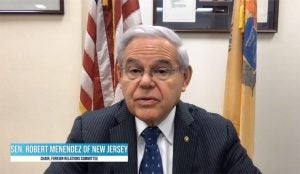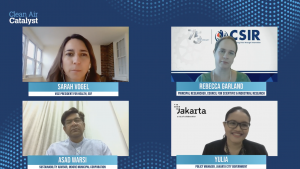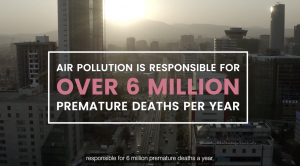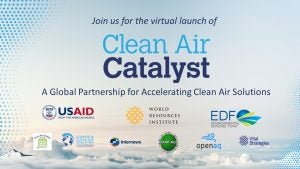



Everybody deserves the right to breathe clean air. Yet air pollution is choking cities and communities around the world – a staggering 9 in 10 people breathe unhealthy air.
City leaders need to urgently identify and accelerate solutions across the world. That’s why the U.S. Agency for International Development (USAID) is launching a bold initiative – called Clean Air Catalyst – to help cities around the world reduce air pollution by advancing solutions that protect health, promote equitable prosperity and tackle the climate crisis. Through a global consortium of organizations led by the World Resources Institute (WRI) and Environmental Defense Fund (EDF), Clean Air Catalyst will begin in two pilot cities: Indore, India, and Jakarta, Indonesia. In Jakarta, WRI Indonesia is the implementing organization.
To mark the initiative’s official launch, hundreds of people from around the world attended a virtual conversation on clean air, health and climate solutions with U.S. Senator Bob Menendez and USAID’s Karl Fickenscher, as well as representatives from partners and the pilot cities. Here’s what you need to know.
Improving health for vulnerable communities
Air pollution is the greatest environmental threat to human health – causing more than 6 million premature deaths each year. Karl Fickenscher, representing the USAID Bureau for Development, Democracy, and Innovation, said, “Eighty percent of these deaths are in low and middle-income countries, and the current trends could result in a staggering 10 million deaths per year by 2050.”
Poor air quality affects nearly every organ in the body and increases risk of heart and lung diseases, including asthma. Children, older people and low-wealth communities often experience the worst outcomes.
Clean Air Catalyst will work with communities, as well as governments and the private sector, to develop local solutions that protect people’s health.
“This is a matter of public health, of equity and of environmental justice,” said Senator Menendez. “The Clean Air Catalyst is a vital global flagship program that will build upon the knowledge and expertise of the United States to work with communities on the frontlines in developing and sustaining progress toward cleaner and healthier air.”
City partners
The Clean Air Catalyst program will initially work in Indore, India and Jakarta, Indonesia. Each of these cities suffers from poor air quality and has unique air pollution challenges.
Indore has made great strides over the past several years to become a cleaner, more sustainable city. As Asad Warsi, the Sustainability Advisor for Indore Municipal Corporation, noted, “Now is time to focus on improving air quality.” He also stressed the importance of raising awareness as a starting point.
Yulia, Policy Manager in the Jakarta City Government, said a few years ago “Jakarta realized it had a real problem.” But to solve the air pollution problem, she noted the importance of working together and getting citizens involved. “The government cannot do it alone – we are a city of collaborations. We want to move from city as provider to city as collaborator to achieve a common goal.”
Understanding local sources
“As scientists, a key pillar of our work is to focus on source awareness and source attribution,” said Rebecca Garland, principal researcher at the Council for Scientific and Industrial Research in Pretoria, South Africa. “Working with local experts and officials we’ll use a variety of approaches to develop air quality modeling and update the emissions inventory, which is a database of pollution sources.” Garland is also a steering committee member of MAP-AQ, one of the Clean Air Catalyst partners.
The main drivers of pollution can be different depending on the area or even the time of year. Yulia said, “We have to know first what the sources are. Based on a study in Jakarta, we found a difference in air pollution sources between the wet and dry seasons. But transportation remains the primary sector for air pollution.”
By pinpointing which activities are causing pollution and collaborating with multiple sectors across society, city leaders can identify solutions that lead to sustained progress on cleaner air and have the biggest health benefits.
Like in Jakarta, transportation is heavily contributing to air pollution in Indore. Warsi said the city is already taking action to address this. “Recently in Indore we have moved to EVs in a big way – in public transport and private.
Climate benefits
Many sources of air pollution – like burning fossil fuels – that damage our lungs are also damaging our climate. Climate change can also intensify the impacts of air pollution and vice versa. For example, extreme heat can cause an air mass to hover over the same area for several days, preventing air pollution from clearing out.
“We also know that many of the same pollutants that degrade air quality around the world also contribute to the existential threat of our time: climate change,” said Senator Menendez.
By approaching solutions through the lens of both air quality and climate, tackling one problem can address the other.
“The good news is that our actions can make a difference. Reducing air pollution could avoid an estimated .6 degrees Celsius of warming by 2050, slow the pace of arctic warming and help alleviate urban heat islands,” Senator Menendez added.
Local clean air solutions can improve public health and lessen climate change impacts, but action is still lagging. “Solving this crisis will require global leadership and global action. We need cooperation and partnerships at all levels,” said Fickenscher.
Clean Air Catalyst will work with these two cities to better understand their specific air pollution challenges, so we can identify and accelerate targeted solutions to reduce pollution and improve people’s quality of life.
The launch webinar and additional information is available at http://cleanaircatalyst.org.
